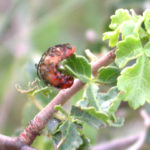One phase of the “Beetles of Peru” project is winding down, so I am pulling new/overlooked projects to the front burner. Baby cassidines – eggs, larvae, and pupae – are needing some love and attention. I tackle these species stories in stages, first with fieldwork to find them and assemble fresh samples, second the requests to museums for loans of their specimens), then third, the natural his

tory paper to lay out what we know and identify gaps in behavior, biology and morphology. My next effort is to do a detailed morphology study, usually as a separate paper.
Aack and alas, a long time has gone by between paper 1 and paper 2 on several of these life cycle studies — I am liable to annoy my good collaborators on these projects. Once those two kinds of manuscripts (natural history & morphology) are secured, I can work on a more integrative comparative study across species and genera (e.g., Chaboo & Nguyen 2004).
I day-dream of that future grand monograph on the juvenile stages of Cassidinae……but today that goal must inspire the 99% of labor in projects as I pull my ethanolic samples, check them twice (ethanol levels, labels, databases, field images), and sonicate individuals for dissections and scanning electron microscopy.
Sonication is the use of sound to agitate particles (see: https://en.wikipedia.org/wiki/Sonication). My sonicator is the type used by jewelers, Ultrasonic Cleaner by Branson. My model is such a nice well-behaved tool that I bought as a Masters student and which has traveled me to various labs, doing exactly what I needed it to do. How cool is that for a piece of lab equipment?! Maybe I should be listening to Sonic Youth while I rock my babies with sound waves? Those waves help dislodge debris and dirt and leave pretty clean insects. I can help the process along by using insect pins to scrape resistant crud, especially from around the mouth and grooves on the body.
Insects are generally clean animals, always fussing with their hairs and brushing their surfaces, because they cannot afford interference in their perception of the environment and enemies. But baby insects tend live in cryptic places, creeping on surfaces, and not preening as much. Many cassidines that live in grooves they hollow (by eating channels into the plant epidermis) on leaves or in tightly-spaced leaf axils tend to be quite dirty. I must give them a spa treatment before they are presentable for their scientific photo shoot!
Comments are closed.